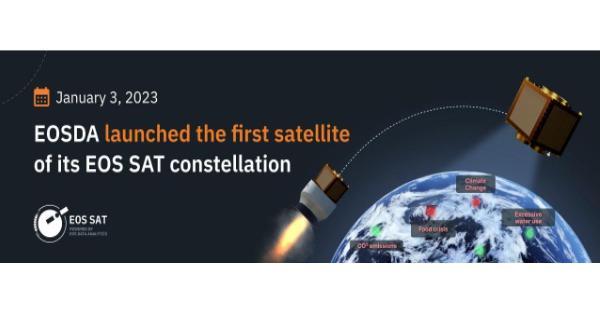(MENAFN- EIN Presswire) EOS SAT satellite
The launch of EOS SAT-2 and the remaining five units of the satellite constellation is planned for 2023-2024
CALIFORNIA, MOUNTAIN VIEW, UNITED STATES, March 14, 2023 /einpresswire.com / -- On January 3, 2023, eos data analytics , a provider of geospatial analytics that develops unique, sustainable crop monitoring systems, launched EOS SAT-1. It is the first unit of the satellite constellation, the work of which will cover the needs of agriculture with reliable and up-to-date data. The EOS SAT project is unique because it's the first time a company that created its remote sensing-based solutions will launch a swarm of 7 optical satellites. The launch took place at the Cape Canaveral Space Force Station in Florida. A SpaceX Falcon 9 rocket delivered an EOS SAT-1 to low Earth orbit.
Dragonfly Aerospace provides technology solutions for satellite systems and is building EOS SAT vehicles. Vertical integration of Max Polyakov's Noosphere group of companies – EOSDA, Flight Control Propulsion, DF, and SETS, provides an entire cycle of the operational process.
It's expected that the agro-focused satellite swarm will reach its total capacity by 2025 and provide more valuable opportunities to farmers all over the world. After that, it will be able to cover 100% of the countries with the most extensive farming and forest lands, which will be 98.5% of their global area.
EOS SAT will enable agribusinesses tracking crop development at every stage and detecting different threats to the plants on time, including water stress, weeds, and pests. In addition to ag crop monitoring, the work of the satellite swarm is aimed at reducing the negative impact of farming on the environment.
One of the goals of this project is to help farmers and large agricultural enterprises to optimize resource consumption. Remote sensing data displayed on productivity and vegetation maps enables more efficient resource use decisions. It will also provide a reliable method for testing the effectiveness of crop protection items and fertilizers while reducing the need for scouting and the amount of consumed fuel.
Upon reaching total operating capacity, EOS SAT will provide daily satellite crop monitoring over an area of about 12 million square kilometers. It will also use 13 agricultural-related spectral bands to provide users with the necessary farm data from certain parts of our planet. The cameras of seven optical satellites will generate panchromatic and multispectral images.
Equipped with 11 agri-related bands EOS SAT-1 is monitoring up to one million square kilometers of farmlands daily. Thus, with a single satellite, EOSDA can help their customers to implement practices of sustainable farming, reducing carbon emissions, and decreasing the consumption of energy, water, and other resources.
Artiom Anisimov, CEO of EOS Data Analytics, congratulates the entire team on launching the first satellite of the EOS SAT constellation and notes that satellite technologies open up revolutionary opportunities for agriculture. He also says that even one spacecraft in the orbit gives the company access to its own set of data, which will provide more accurate and comprehensive information to EOSDA customers.
Speaking about the launch of EOS SAT, Bryan Dean, CEO and co-founder of Dragonfly Aerospace, points to the growing demand for lightweight satellites with high performance and the development of the satellite technology market. Commenting on the partnership with EOS Data Analytics, he also notes the company's focus on solving problems and establishing the sustainability of life on Earth. The data that EOS SAT will collect will help achieve this goal by assisting producers in making better decisions to conserve biodiversity and maintain food security.
The launch of EOS SAT-2 and the remaining five units of the satellite constellation is planned for 2023-2024. By obtaining data from its own source, EOSDA will be able to work independently of third-party satellite imagery providers. EOS SAT will revisit once every three days, providing a massive amount of reliable and up-to-date remote crop monitoring data to meet the needs of the company's customers.
Building a Virtual Spacecraft with EOSDA
EOS Data Analytics also created an interactive website where users can learn about the process of building and launching satellites.
The EOSDA Virtual Satellite Website offers an easy and fun way to learn about innovative technologies that are transforming human activities. This website will interest children and adults who want to learn in an interactive environment about how satellites are assembled and launched, as well as their future work and impact.
The shown process is based on the building of EOS SAT-1. Website visitors are invited to learn about the five main components of building such a spacecraft. It's also a place where interested users can get basic information about the operation of such a vehicle.
Launching a satellite into low Earth orbit is quite complex. The EOS SAT Launch section shows details of each step of this process. Visitors of the site can watch an animation of the launch sequence of the satellite into orbit.Serhii Mishchenko
email us here
MENAFN14032023003118003196ID1105775308
Legal Disclaimer:
MENAFN provides the
information “as is” without warranty of any kind. We do not accept
any responsibility or liability for the accuracy, content, images,
videos, licenses, completeness, legality, or reliability of the information
contained in this article. If you have any complaints or copyright
issues related to this article, kindly contact the provider above.



















Comments
No comment